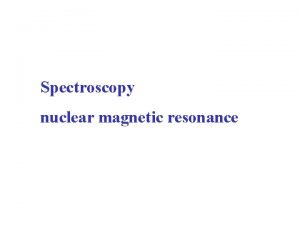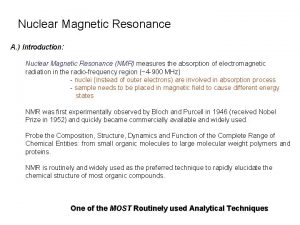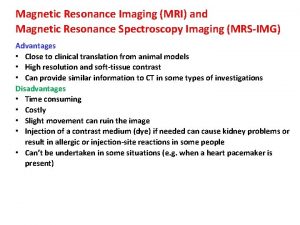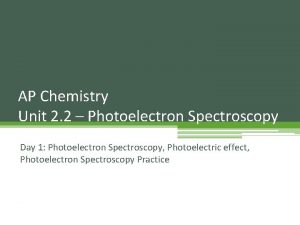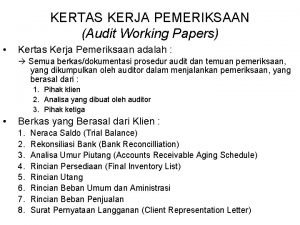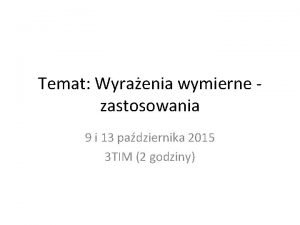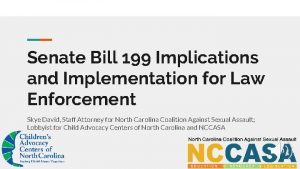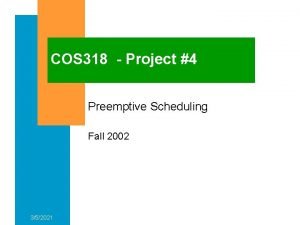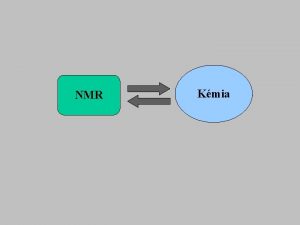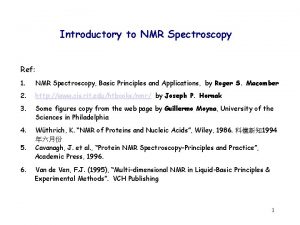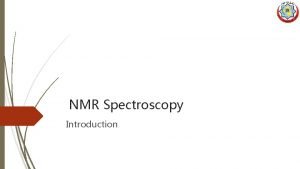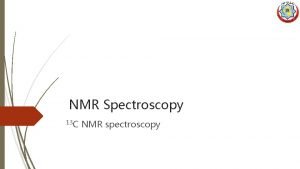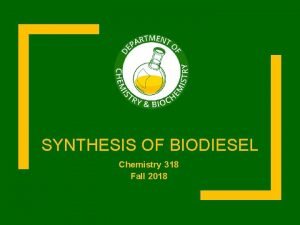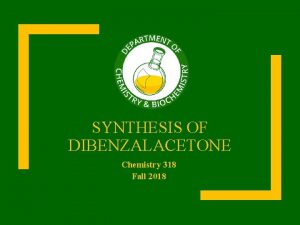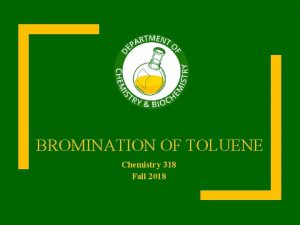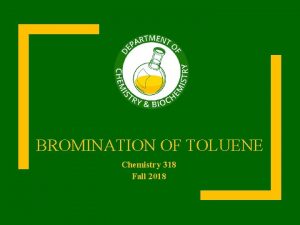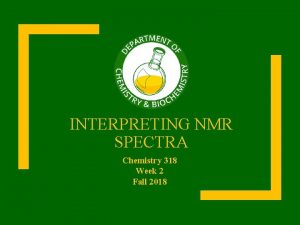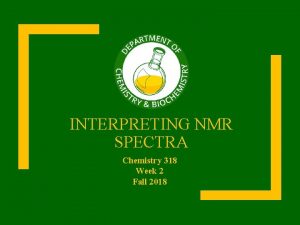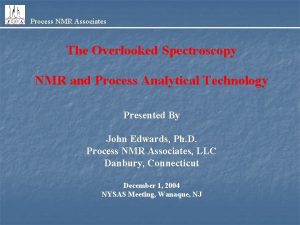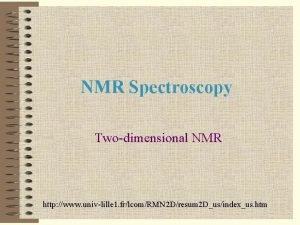NMR UNKNOWN SPECTROSCOPY Chemistry 318 Fall 2018 Schedule














- Slides: 14

NMR UNKNOWN SPECTROSCOPY Chemistry 318 Fall 2018

Schedule of day ■ PPE check – at the door ■ Pre-lab check – at the door ■ Quiz ■ Recitation – Friedel- Crafts Synthesis, part II – Identification of Unknown, part I ■ Safety – Put bags away – Goggles – Gloves – Lab Coat ■ LAB!

Due Dates ■ Today: – Nitration Report (Separation Scheme turned in last week and returned to you today – part of overall report). – Spectroscopy Problem Set, Part II #3 – At the end of lab – yellow notebook page copies ■ Next Week: – Synthesis of 4 -4’ di-tert-butylbiphenyl Report (Sep. Scheme + Report Form + written report) – Spectroscopy Problem Set, Part II #4 ■ Two Weeks: – Identification of Unknown Report

Grading from last week ■ Notebooks- common omissions: – not citing the physical properties of compounds. You had to look them up (in an approved source); so record the source WITH A UNIQUE ID. – Missing chemical equation (for a synthesis lab? ? ). – Missing glassware sketch ■ Spectra problem – We all know the answers are “out there”. But to give the wrong structure answer, which is contrary to the analysis, and which could easily be confirmed or not by looking in SDBS, is not a smart move!

Report for Next Week ■ The Friedel-Crafts alkylation report + Sep. Scheme are due ■ Please review the errors you made on the Nitration Separation Scheme, returned to you today. There will be more of these this semester (20 -25 points toward total report grade). ■ Main points for the Separation Scheme: ■ – all starting materials, products and potential by-products (as mentioned in the Manual) should be included. – every compound present at the beginning must be separated out from the final product. – “separation” procedures include extraction; filtration; decantation; distillation; evaporation/air-drying. – it is helpful to print the flow chart provided on the web site. If you have questions about how it was graded, please ask. Answer key is available.

Today in Lab: Part II of Friedel. Crafts Synthesis ■ Today, while you are waiting to use the IR or refractometer and after distillation: – Record mass of product – Take melting point of product

Today in Lab: Identification of an Unknown ■ Physical Properties: – Physical Characteristics of Unknown (color, odor, etc. ) – Boiling Point & Purification (Simple Distillation) – Refractive Index with temperature correction – Solubility (Relative to Water) – Density (Relative to Water) ■ Infrared Spectrum ■ Next week, take 1 H-NMR spectrum in GMU NMR Center, room 18 PH

Simple Distillation notes ■ Use lab jack to adjust height of hot plate. ■ Firmly attach utility clamp to distillation flask and ring stand. ■ Use second utility clamp attached to condenser and ring stand. ■ Use blue Keck clamps to secure the other parts of the apparatus. ■ Ensure that the water inlet/outlet tubes face upwards so that they avoid the hot plate ■ Insert thermometer through adapter so that the bulb is positioned just below elbow opening to condenser

Simple Distillation notes ■ Use boiling stones! ■ Receiving flask immersed in ice bath. ■ You may need wrap the distilling flask and head in Al foil (shiny side in). ■ Do not distill to dryness!

Solubility/Density Relative to Water: ■ Add 2 – 4 m. L distilled water to test tube. ■ Add 4 – 5 drops of purified distillate (or 3 mg of solid sample) to test tube. ■ Stopper test tube with gloved finger. – Shake vigorously ■ Note the following: – Did the sample dissolve? – If the sample did NOT dissolve: – ■ Does the sample float on top of liquid? ■ Does sample float in middle of liquid, or disperse throughout the liquid? ■ Does it settle to the bottom? Is the sample soluble or insoluble in water? More or less dense than water?

Refractive Index ■ See Manual p. 45 and Mohrig 13. 3 -13. 4. ■ Clean prisms with tissues and methanol – Be GENTLE!! ■ Do NOT touch prism with fingers, or hard objects, just the tissues. ■ Use 2 – 3 drops of sample. ■ Close hinged prisms together – gently. ■ Turn on the light. ■ Move hinged lamp up into position.

Refractive Index ■ This is what you will see when performing refractive index ■ Line up the crosshairs properly ■ Read numerical scale carefully! – Draw what you see in your lab notebook ■ Record to 4 decimal places!

Refractive Index ■ Make sure you understand how to temperaturecorrect and record the refractive index. This is the notation used to report the refractive index: n DT – The subscript “D” denotes the wavelength of light, which is 589 nm. –The superscript “T” denotes the temperature of measurement or the correction to a different temperature. –Both of these, the ref. index at room temp. and the corrected ref. index must be reported.

IR Spectroscopy ■ Take an IR – IR (and all tests) must be done on the distilled compound. – When you are finished distilling, and cleaned up, you can put your name on the whiteboard to take your turn at the spectrometer. ■ Keep your distilled unknown until after your report is graded. – Keep your unknown in the class drawer!
 Dept nmr spectroscopy
Dept nmr spectroscopy P-diethylbenzene nmr
P-diethylbenzene nmr Nmr spectroscopy diagram
Nmr spectroscopy diagram Factors affecting chemical shift
Factors affecting chemical shift Advantages and disadvantages of spectroscopy
Advantages and disadvantages of spectroscopy Photoelectron spectroscopy pogil
Photoelectron spectroscopy pogil Pes2p
Pes2p Dada la siguiente secuencia rusia 2018 rusia 2018
Dada la siguiente secuencia rusia 2018 rusia 2018 Contoh top schedule dan supporting schedule
Contoh top schedule dan supporting schedule January 2017 chemistry regents answers
January 2017 chemistry regents answers Chemistry fall semester exam review answers
Chemistry fall semester exam review answers Wyrażenia wymierne zastosowania
Wyrażenia wymierne zastosowania Ncgs 14-27
Ncgs 14-27 Pra onde eu irei salmos
Pra onde eu irei salmos Cos 318 princeton
Cos 318 princeton

